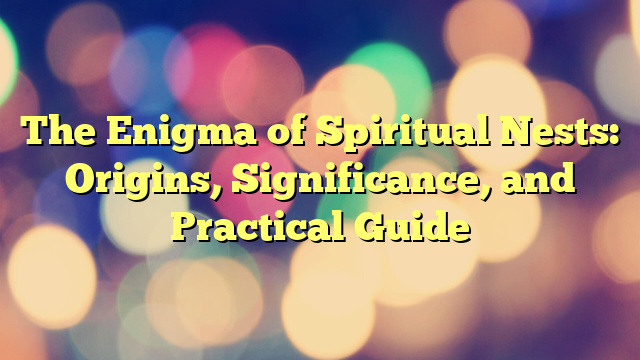The world of spirituality is vast, encapsulating countless practices, beliefs, and symbols. One such fascinating concept is the “Spiritual Nest.”
Defining a Spiritual Nest
A Spiritual Nest is a personal sanctuary created with the intent of fostering spiritual growth and exploration. These nests serve as a safe space for introspection, healing, and manifestation, facilitating a deep connection with one’s inner self and the universe at large.
Origins and Cultural Context of Spiritual Nests
While the term “Spiritual Nest” might be relatively new, the idea of sacred personal spaces for spiritual practices is ancient. From the Buddhist concept of personal meditation spaces to the Native American tradition of personal altars and sweat lodges, the desire for a place dedicated to spiritual progress is universal across cultures and religions.
Elements and Construction of a Spiritual Nest
Physical Elements
Spiritual Nests often include elements that reflect personal beliefs or facilitate spiritual activities. This may include religious or spiritual icons, natural elements like crystals or plants, incense, candles, meditation cushions, or anything else that holds spiritual significance for the individual.
Energy and Intent
Perhaps even more important than the physical elements is the energy and intent that go into the creation of the nest. This space is meant to be imbued with positive energy, and each element within it is often chosen with specific intentions in mind.
Interactions and Experiences with Spiritual Nests
Personal Practices
An individual might use their Spiritual Nest for a range of activities, including meditation, yoga, prayer, reading spiritual texts, or other forms of introspection and self-care.
Group Practices
Some nests may also be designed to accommodate small groups, facilitating shared spiritual experiences like group meditations or ritual practices.
Variations Across Communities
While the concept of a Spiritual Nest is universal, the specifics can vary widely depending on cultural background, personal beliefs, and individual needs. Some may incorporate elements of their religious faith, while others may draw from a range of spiritual traditions or focus on secular mindfulness practices.
Creating Your Own Spiritual Nest
Environment
Choose a space that feels calm and private, where you won’t be easily disturbed.
Materials
Gather items that have spiritual significance for you. These could include religious icons, crystals, incense, candles, or anything else that helps you connect with your spirituality.
Intention Setting
As you arrange your space, set an intention for each element you include. This can help to imbue the space with a specific energy that supports your spiritual journey.
Conclusion
A Spiritual Nest can be a powerful tool in one’s spiritual journey, providing a dedicated space for introspection, growth, and connection with the divine. As with any spiritual practice, the key is to make it your own, infusing it with your personal beliefs, intentions, and energy.
FAQs
- What is a Spiritual Nest? A Spiritual Nest is a personal spiritual sanctuary created to foster introspection, healing, and spiritual growth.
- How do I create a Spiritual Nest? Choose a calm, private space and fill it with items that have spiritual significance for you. Set an intention for each element and the space as a whole.
- Can a Spiritual Nest accommodate group activities? Yes, depending on the size and design of the nest, it may be used for group meditations or rituals.
- Is a Spiritual Nest tied to a specific religion or belief system? No, a Spiritual Nest is a universal concept and can be adapted to fit any belief system or spiritual practice.
